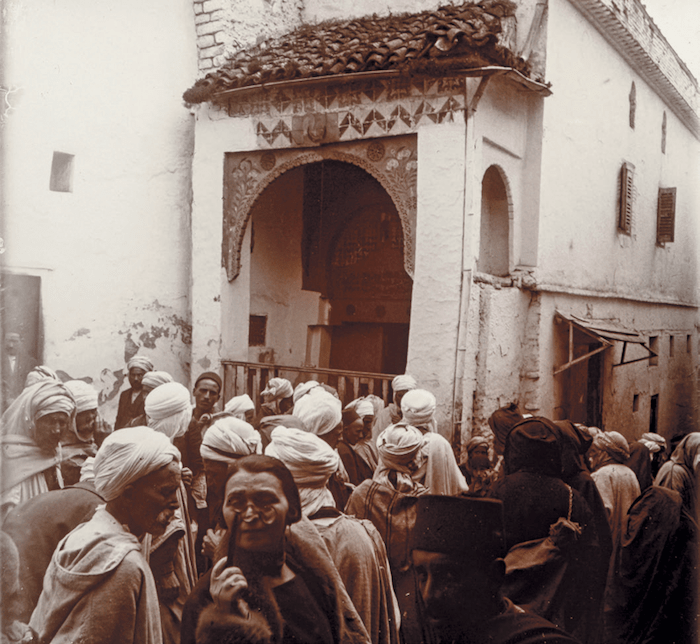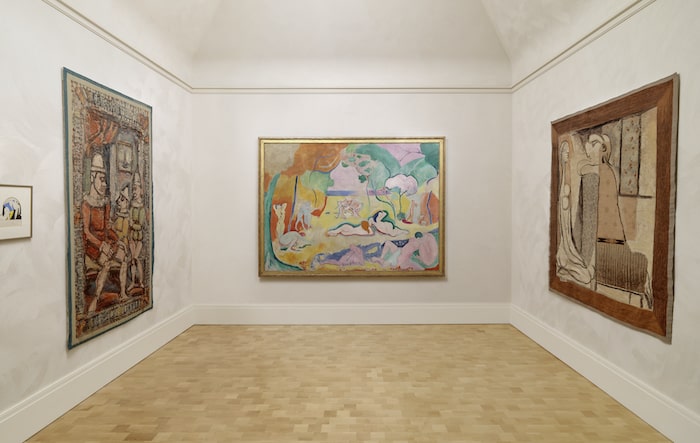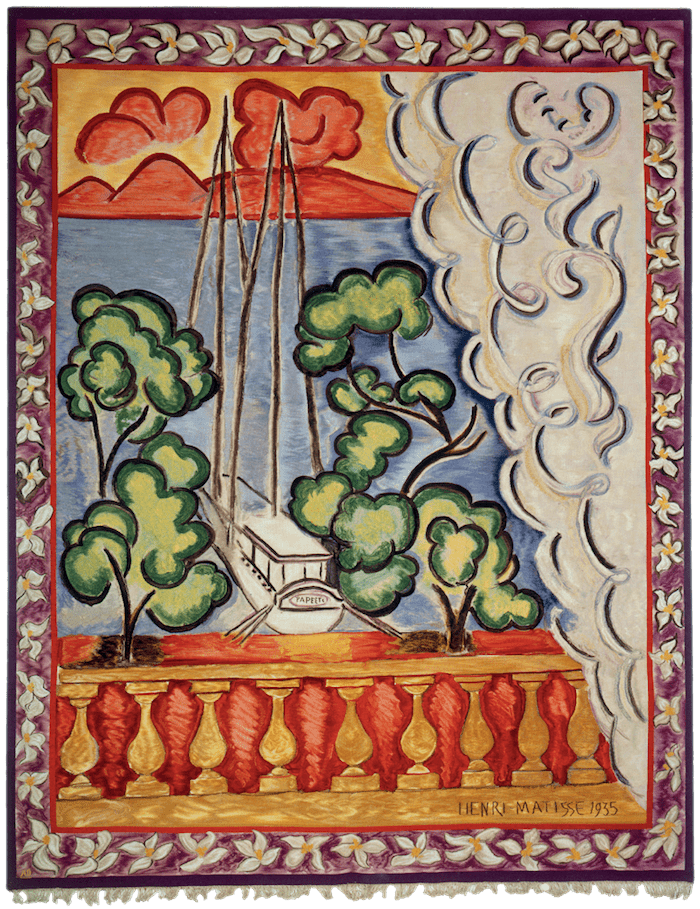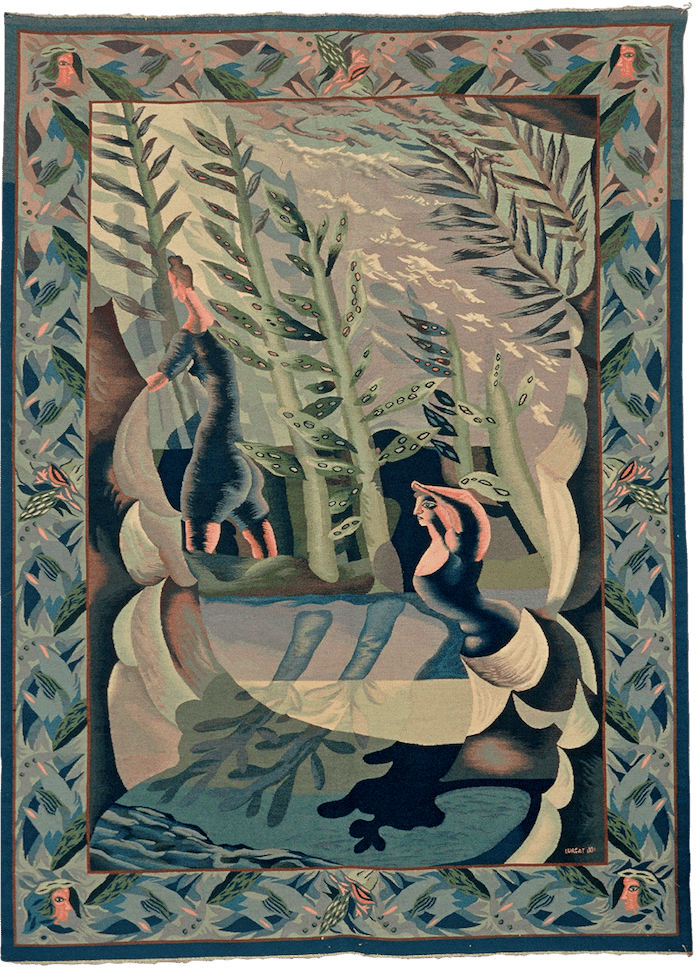Marie Cuttoli’s Bold Revival of the French Tapestry Tradition
For Marie Cuttoli, her fame as an art entrepreneur and work with key modern artists and the traditional tapestry industry started with rugs. In a way, it also ended with rugs as she, according to Cindy Kang, Associate Curator of the Barnes Foundation, was “shoved under the rug” after World War II as her work was criticized and she was mostly forgotten.
But the Philadelphia Barnes Foundation exhibit, Marie Cuttoli: The Modern Thread from Miró to Man Ray, reestablishes Cuttoli as a visionary entrepreneur whose early work in fashion and interiors (those rugs again) inspired her to bring together modern artists and the French tapestry industry that needed a revival after World War I. The Barnes Foundation reopens on Saturday, July 25, and will meet all required health and safety protocols for staff and visitors. The exhibit will close on August 23, 2020.
Cuttoli was born in 1879 in Tulle, a town in central France where her father managed a tavern and her mom raised three children. But Tulle was part of the traditional French textile industry (Tulle is the name of a fine net fabric) and when the family moved to Paris her father sold cotton and linen fabrics from Tulle for sheets and dishcloths.

Marie Cuttoli in Algeria, c. 1925. Photograph by Henri Laugier (French, 1888–1973). Collection of Professor Julien Bogousslavsky
She married an Algerian-born French politician, Paul Cuttoli, who was elected senator from Constantine, Algeria, and she began to split her life between Paris and Algeria. Her entrepreneurial side awoke in this ancient city.
“She explored her new, adopted homeland with its indigenous arts and crafts, including embroidery and tapestry,” said Kang. “It was common as a ‘colonial wife’ to do so.”
But Cuttoli took it farther. She enjoyed modern art and opened up a Paris fashion house, called Myrbor, which allowed her to commission modernist designs from artists in Paris for local Algerian women to weave and promote indigenous crafts. Although much of her product was fashion, she began to focus on interiors, starting with rugs. She commissioned designs from the likes of Fernand Léger and Pablo Picasso and hired women in the workshops of Sétif, a city west of Constantine, to weave the rugs. Eventually, Cuttoli began to hang the rugs on the wall which elevated them to more of an art status.

Rouault’s Little Family (left) and Picasso’s Secrets (right) with Matisse’s painting Le bonheur de vivre, The Barnes Foundation, Philadelphia, Pennsylvania 2012. Image © 2020 The Barnes Foundation
According to Kang, Myrbor promoted an African/French Algerian image with Myrbor products which “helped her gain ground in the crowded marketplace for fashion and interior design.”
The traditional French tapestry industry was having its own issues. From a long history of royal (Gobelins in Paris) and private (Aubusson in central France) manufacturing, after the French Revolution the industry faltered. There had been several attempts to revive the industry, but World War I and the Great Depression took a deeper toll. Cuttoli, now in her early fifties, saw an opportunity for a risky venture. She commissioned a wide variety of modern artists to design tapestries for production in Aubusson.

Window in Tahiti (Papeete), 1936. Designed by Henri Matisse (French, 1869–1954). Woven by Atelier Delarbre, Aubusson. Wool and silk, 88 × 68 in. (223.5 × 172.7 cm). Private collection
What attracted the likes of Miró to Man Ray to join Cuttoli in this new venture?
“First, tapestry was part of a new interest by these artists,” said Kang. “Murals were popular as a type of wall replacement that created a different environment in a room. It was felt that large interior art would contribute to wellbeing. Second, the ancient art (of tapestry) gave these modern artists legitimacy. Great influential artists such as Raphael and Rubens had also created tapestries.”
For the artists, the process of developing a tapestry was very different than painting. It’s a collaborative process between the artist and the weaver and weaving is a different way to interpret lines, shapes and colour. Artists create designs in the form of large-scale cartoons, or original art. The weavers then use the cartoon to create the tapestry which can take months, or longer. There is a huge difference between using a paint brush to make a line or shape in one stroke versus weaving one thread from a bobbin (or broche) in a horizontal line (the weft) through a mass of vertical threads (the warp) that make up the structure of the tapestry. Each weaver views the cartoon in front of them and it is drawn on the warp, but weaving is done with the weaver sitting on the back side of the tapestry. They don’t see the front of their work directly but via a mirror placed in front of the tapestry. The techniques for making tapestries has not changed significantly since the Middle Ages. Check out the art in making a tapestry in this video from Gobelins.
Cuttoli as the person commissioning the artwork was between the modern artists and the weavers and signed contracts with them for approval of the outcome. Some of the artists had no problem while others did. The reality is that the two mediums are different, and the tapestry artist interprets the design to be best created in the warp and weft of strings of wool and silk with no room for trial and error. If anyone has ever sewn, crocheted, embroidered or woven an object, they understand that the weaver’s job is a mixture of craft and art.
The initial result was an amazing collection of 17 tapestries by seven modern artists that made their world debut at a New York art gallery in 1936. At that time, the American art market offered more opportunities and Cuttoli also wanted to expand the perception of what fine art could be. It was a “groundbreaking” experience, according to Kang.
During this time, Cuttoli met Albert C. Barnes and their advocacy included Barnes purchasing several of the tapestries from Cuttoli. The value of the works of art at that time ranged between $1,200 and $6,000, according to Kang.
In 1939, the Cuttoli exhibit, called Modern French Tapestries, was shown at both the Golden Gate International Exposition in San Francisco and the San Francisco Museum of Art (SFMA,) now called the San Francisco Museum of Modern Art (SFMOMA.) Twenty-three tapestries were in the International Exposition and 19 were at SFMA. Both exhibits were popular and attracted more than 10 million visitors at the Exposition alone.

The Storm (L’orage), c. 1933–35. Designed by Jean Lurçat (French, 1892–1966). Woven by Atelier Delarbre, Aubusson. Wool and silk, 91 3⁄8 × 66 7⁄8 in. (232 × 170 cm). Musée Jean-Lurçat et de la tapisserie contemporaine, Angers
But with the start of World War II and the German occupation of Paris in 1940, Cuttoli fled to the United States. Barnes helped obtain her an emergency visitor visa, and Modern French Tapestries, detained in the U.S. due to closed borders, became a touring exhibit managed by Grace McCann Morley, founder of SFMA. For six years, the exhibit traveled to 20 U.S. cities including Portland, Oregon; Detroit; Cleveland; Baltimore and even Honolulu.
In the ensuing years, the controversy over the level of art for the tapestries continued. Is tapestry trespassing into another art form? Are decorative arts ever fine art? Are these tapestries merely colour reproductions for the rich? Cuttoli’s name and contributions were in the middle of it all and she was often criticized for her work and eventually “shoved under the rug” and forgotten.
But the beauty of the Barnes Foundation Cuttoli exhibit is both viewing the art and the tapestry technique plus Cuttoli’s contribution. The blend of old and new, ancient and modern, craft and art. The teamwork involved in the creation. The exhibit is a full view of history rediscovering that Cuttoli helped revitalise an industry that needed help and expanded the mediums in which modern artists created, and she made their work more popular. As Kang said, “She promoted modern art as part of daily life.”
Share to: Facebook Twitter LinkedIn Email
More in French tapestries, Marie Cuttoli
Leave a reply
Your email address will not be published. Required fields are marked *





